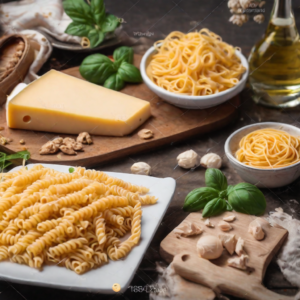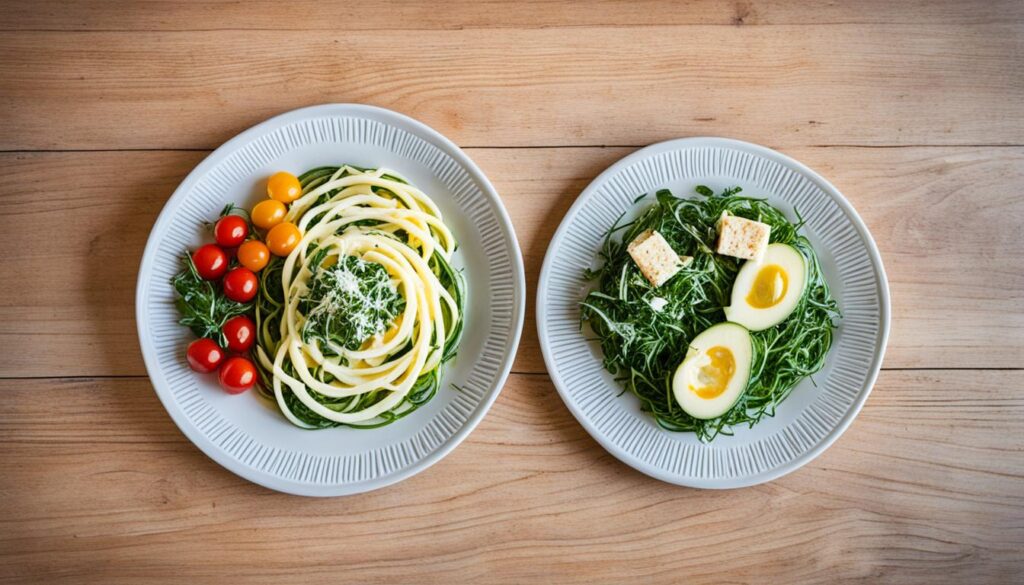Is Cheese Keto & Pasta Gluten | Status Unveiled

Cheese and pasta are two beloved food items that have sparked curiosity regarding their compatibility with specific dietary choices. Many wonder if cheese is keto-friendly, while others question the gluten content in pasta. In this article, we will dive into the world of cheese and pasta to uncover the truth behind these common assumptions. Get ready to discover whether cheese can be enjoyed on a keto diet and whether pasta options exist for those avoiding gluten.
Key Takeaways:
- Cheese is generally keto-friendly due to its low carbohydrate content and high fat content.
- While traditional pasta is not gluten-free, there are now gluten-free pasta alternatives made from alternative flours.
- When incorporating cheese into a keto diet, it’s important to choose options with minimal carbohydrate content.
- Gluten-free pasta recipes offer a range of delicious options for those following a gluten-free diet.
- Understanding the keto-friendliness of cheese and the gluten status of pasta is essential for making informed dietary choices.
Is Cheese Keto?
Cheese is a delicious and versatile food that can be enjoyed on a ketogenic diet. It is low in carbohydrates and high in fat, making it an excellent choice for those following a keto lifestyle.
While some cheeses may contain trace amounts of carbohydrates, most varieties are considered keto-friendly. They provide a good source of protein and essential minerals, making them a nutritious addition to any keto meal plan.
It’s important to note that portion control is still necessary when consuming cheese on a ketogenic diet, as it can be calorie-dense. Moderation is key to ensure you stay within your daily macronutrient goals.
“Cheese is a delicious and versatile food that can be enjoyed on a ketogenic diet.”
When incorporating cheese into your keto diet, opt for cheeses that are naturally low in carbohydrates and high in fat. Some keto-friendly cheese options include:
| Cheese Type | Carbohydrate Content per 1 oz (28g) | Fat Content per 1 oz (28g) |
|---|---|---|
| Cheddar | 0g | 9g |
| Mozzarella | 1g | 6g |
| Brie | 0g | 8g |
| Cream Cheese | 1g | 9g |
These cheeses have minimal carbohydrate content and provide healthy fats, which are essential for achieving and maintaining ketosis.
“When incorporating cheese into your keto diet, opt for cheeses that are naturally low in carbohydrates and high in fat.”
Remember to read the nutrition labels and choose cheeses that align with your specific macronutrient goals. By including keto-friendly cheese in your diet, you can add flavor and richness to your meals while staying on track with your ketogenic lifestyle.
The Gluten Status of Pasta
Pasta is a beloved staple in many cuisines around the world. However, for individuals with celiac disease or a gluten sensitivity, the gluten content in traditional pasta poses a problem. Gluten is a protein found in wheat flour, which is the primary ingredient in most pasta recipes. This protein gives dough its elasticity and helps it retain its shape, but it can cause adverse reactions in those with gluten intolerances.
To accommodate individuals who need to avoid gluten, there are now gluten-free pasta options readily available in the market. These alternatives are made from alternative flours such as rice, corn, or legumes, and they provide a suitable option for those seeking gluten-free alternatives.
By opting for gluten-free pasta, individuals can still enjoy their favorite pasta dishes without compromising their dietary needs. These gluten-free options offer a similar taste and texture to traditional pasta, making them a viable substitute for gluten-sensitive individuals.
Below is a comparison table that highlights the key differences between traditional pasta and gluten-free pasta alternatives:
| Pasta Type | Gluten Content | Ingredients | Taste and Texture |
|---|---|---|---|
| Traditional Pasta | Contains gluten | Wheat flour | Elastic texture, slightly nutty flavor |
| Gluten-Free Pasta | Does not contain gluten | Rice, corn, legume flours | Varies by brand, but typically similar to traditional pasta |
It’s important to note that individuals following a gluten-free diet should always check the labels of pasta products to ensure that they are certified gluten-free. Cross-contamination can occur during processing, so it’s crucial to choose products that are marked as gluten-free to avoid any potential adverse effects.
With the availability of gluten-free pasta alternatives, individuals can still enjoy their favorite pasta dishes while adhering to their dietary restrictions. Whether it’s a comforting bowl of spaghetti or a cheesy baked pasta, gluten-free pasta opens up a world of delicious possibilities.
Next, let’s explore some delicious gluten-free pasta recipes that will satisfy your cravings and suit your dietary needs.
Keto-Friendly Cheese Options
When following a ketogenic diet, it’s essential to choose cheese options that are both delicious and compatible with your dietary goals. Fortunately, there are several keto-friendly cheese varieties to satisfy your cravings while keeping you in ketosis. These cheeses are low in carbohydrates and rich in healthy fats, making them ideal for a keto lifestyle.
Here are some popular keto-friendly cheese options:
- Cheddar: A versatile cheese with a slightly sharp flavor, cheddar is a staple in many keto diets. It’s low in carbohydrates and high in fat, making it perfect for adding flavor to various dishes or enjoying as a snack.
- Mozzarella: Known for its melty texture, mozzarella is a great choice for keto recipes such as low-carb pizza or cheesy casseroles. It’s also low in carbohydrates and provides a good amount of protein.
- Brie: With its creamy and mild flavor, brie is a luxurious option for keto-friendly cheese boards. It pairs well with keto-friendly crackers or can be enjoyed on its own.
- Cream Cheese: Cream cheese is a keto-friendly staple that can be used in both sweet and savory recipes. It’s perfect for making keto-friendly cheesecake or adding a creamy texture to sauces.
To ensure your cheese choices align with your specific macronutrient goals, it’s essential to check the nutrition labels. This will help you stay within your desired carbohydrate and fat intake.
By incorporating these keto-friendly cheeses into your diet, you can enjoy delicious meals while staying in ketosis. Remember to moderate your portion sizes and be mindful of your overall calorie intake, as these cheeses can be calorie-dense.
Gluten-Free Pasta Alternatives
For individuals who need to follow a gluten-free diet, there are numerous pasta alternatives available. These options are made from alternative flours such as rice, corn, quinoa, or legumes. Gluten-free pasta can come in various shapes and sizes, providing a wide range of options for satisfying your pasta cravings. It’s important to read the labels carefully to ensure the pasta is certified gluten-free, as cross-contamination can occur during processing.
Gluten-free pasta offers a delicious and versatile substitute for traditional wheat-based pasta. With different flour options, you can still enjoy your favorite pasta dishes without compromising your gluten-free diet. From spaghetti and penne to macaroni and lasagna, there are gluten-free pasta alternatives available for all your favorite recipes.
Popular Gluten-Free Pasta Types
Here are some popular gluten-free pasta alternatives:
- 1. Rice Pasta: Made from rice flour, this pasta has a similar texture and taste to traditional wheat pasta.
- 2. Corn Pasta: Corn pasta is another common gluten-free option that offers a slightly sweet and nutty flavor.
- 3. Quinoa Pasta: Quinoa pasta provides a nutritious alternative, rich in protein and fiber.
- 4. Legume Pasta: Pasta made from legume flours like lentil, chickpea, or black bean offers a protein-packed option for those looking to boost their protein intake.
When cooking gluten-free pasta, it’s essential to follow the instructions on the package, as cooking times may vary compared to traditional wheat pasta. Overcooking gluten-free pasta can result in a mushy texture, so be sure to monitor the pasta closely while it cooks.

The Gluten Content in Traditional Pasta
When it comes to pasta, one of the key factors to consider is its gluten content. Traditional pasta, made from wheat flour, contains gluten, a protein that provides elasticity and shape to the dough. The gluten content in pasta can vary depending on the brand and type of pasta. Typically, wheat flour contains around 10-14% gluten protein.
“The gluten content in traditional pasta can affect individuals with celiac disease or a gluten sensitivity even in trace amounts.”
For individuals who have celiac disease or a gluten sensitivity, even trace amounts of gluten can be harmful. Therefore, when choosing pasta options, it is essential to opt for certified gluten-free alternatives to avoid any potential adverse effects. By selecting gluten-free pasta, individuals can enjoy their favorite pasta dishes without compromising their dietary needs.
Gluten Content Comparison
| Pasta Type | Gluten Content |
|---|---|
| Traditional Wheat Pasta | 10-14% |
| Gluten-Free Pasta Alternatives | No Gluten |
As shown in the table, traditional wheat pasta contains gluten, while gluten-free pasta alternatives do not contain any gluten. This comparison highlights the importance of choosing suitable options for individuals with specific dietary requirements.
By understanding the gluten content in traditional pasta and the availability of gluten-free alternatives, individuals can make informed choices that align with their dietary needs and preferences.
Incorporating Cheese into a Keto Diet
Cheese is a versatile and delicious food that can be easily incorporated into a ketogenic diet. Its high fat content and low carbohydrate content make it a perfect choice for those following the keto lifestyle. Whether you prefer it as a standalone snack, a topping for keto-friendly pizza, or as an ingredient in various keto recipes, cheese adds a satisfying and flavorful element to your meals.
When incorporating cheese into your keto diet, it’s important to consume it in moderation and be mindful of portion sizes. While cheese is keto-friendly, it is still calorie-dense, so it’s essential to maintain a balance and monitor your overall calorie intake. This will ensure that cheese aligns with your individual keto goals and contributes to your overall dietary success.
Here are some creative ways to incorporate cheese into your keto diet:
- Enjoy cheese as a delicious and convenient standalone snack between meals.
- Add cheese to salads for an extra burst of flavor and creaminess.
- Use cheese as a topping for your favorite keto-friendly pizza recipes.
- Incorporate cheese into keto-friendly recipes such as cheesy cauliflower rice or stuffed chicken breasts.
By incorporating cheese into your keto diet, you not only enhance the taste and texture of your meals but also provide your body with essential fats and nutrients. Remember to choose keto-friendly cheese options that are low in carbohydrates and high in fat to maintain the integrity of your ketogenic diet plan.

“Cheese is a delicious and satisfying addition to a keto diet, offering a wide range of flavors and textures to explore.” – Our Cheese Expert
Gluten-Free Pasta Recipes
With the availability of gluten-free pasta alternatives, there are countless gluten-free pasta recipes to explore. From classic pasta dishes to creative culinary creations, there are endless possibilities for gluten-free pasta recipes. These recipes often utilize gluten-free pasta made from alternative flours and can be customized to suit various dietary preferences and restrictions.
Whether you’re craving a comforting bowl of pasta or looking to try a unique pasta dish, gluten-free pasta recipes offer a wide array of options. Here are a few inspiring recipes to get you started:
1. Lemon Garlic Shrimp Pasta
This refreshing seafood pasta combines succulent shrimp with a tangy lemon garlic sauce. Use gluten-free linguine or spaghetti as the base for this flavorful dish. Toss in fresh herbs like parsley and basil for added freshness.
2. Creamy Avocado Pesto Pasta
Elevate your pasta game with this creamy avocado pesto sauce. Blend ripe avocados, fresh basil, garlic, lemon juice, and olive oil to create a luscious sauce. Toss it with gluten-free penne or fusilli for a vibrant and satisfying meal.
3. Vegetable Primavera
Embrace the flavors of spring with a colorful vegetable primavera pasta. Saute an assortment of seasonal vegetables like bell peppers, zucchini, cherry tomatoes, and asparagus. Combine them with gluten-free rotini or farfalle for a light and wholesome pasta dish.
4. Spicy Arrabbiata Penne
If you’re a fan of spicy food, this arrabbiata penne pasta is sure to satisfy your taste buds. Simmer crushed tomatoes with garlic, red pepper flakes, and Italian seasoning for a fiery sauce. Serve it over gluten-free penne, garnished with fresh basil and grated Parmesan.
These are just a few examples of the delicious gluten-free pasta recipes available. Feel free to experiment with different sauces, proteins, and vegetables to create your own unique pasta creations. Enjoy the flavors and versatility of gluten-free pasta without compromising on taste or texture!
Making Informed Dietary Choices
When it comes to making informed dietary choices, it is crucial to understand the keto-friendliness of cheese and the gluten status of pasta. For individuals following a ketogenic diet, cheese can be a delicious and satisfying option. With its low carbohydrate content and high fat content, cheese is a suitable addition to a well-rounded keto meal plan.
On the other hand, traditional pasta contains gluten, which can be problematic for individuals with celiac disease or a gluten sensitivity. Gluten is a protein found in wheat flour and gives pasta its characteristic texture. Therefore, those who need to avoid gluten should opt for gluten-free pasta alternatives made from rice, corn, or legumes.
By considering these factors, individuals can tailor their diet to meet their specific needs and preferences. Enjoying cheese on a keto diet, while opting for gluten-free pasta, enables individuals to maintain a balanced and satisfying eating plan. By being aware of the keto-friendliness of cheese and the gluten status of pasta, we can make informed dietary choices that support our health and well-being.

Leave a Reply